Notes from the editor
Watchful eyes ?
Only the most watchful eyes can spot the elusive slender loris (thevangu) in the forests of KMTR. Nocturnal and cryptic, the slender loris can be sighted in the dry evergreen forests of Mundanthurai plateau and is perhaps the most severely impacted mammal during the huge annual temple festival. Yet, this animal usually falls below the radar of conservationists perhaps due to lack of 'charisma', a value or tag attached to an animal to campaign for biodiversity conservation. Such unspoken of species and consequences of popular conservation measures are the focus of this issue of Agasthya. The collection of articles suggests that the primary challenge for conservationists is a nuanced understanding of ecological and social processes that govern the survival of species. Else, while we celebrate the success of protecting charismatic species, other species may suffer right under our watchful eyes.
- Allwin Jesudasan
A tale of the 'Broad Tailed Grassbird'
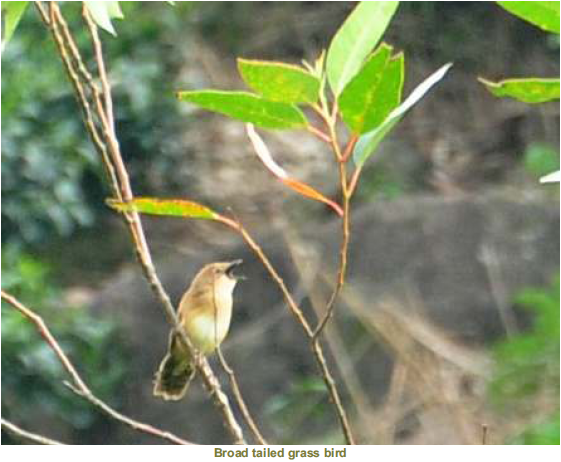
It was a cloudy morning in the middle of June in 2011 and yet the rain in Kodayar was hardly a trickle. I was returning from Kakachi with Preeti and Chian after searching for frogs the previous night. We rode past a swamp in Nalmukh tea estate when a sharp warbling call caught our attention. Tired and weary, we did not stop to investigate but kept going and as we navigated a curve, it occurred to me that the bird could be the Broad Tailed Grassbird (Schoenicola platyurus). We got off the bike and ran to investigate. The sky was overcast and a light drizzle brought out a nip in the wind. The calls were incessant. It came from the base of two eucalyptus trees. The swamp had a lot of thick sedge growing in it. As we intently waited, the bird flew out from a clump of sedges and perched on the tree and began warbling. One could clearly see the black mouth inside when it was calling. The broad tail too was distinct. Elated on seeing an endemic and vulnerable bird in a tea estate, we tried to photograph the bird in vain.
I had on one earlier occasion, seen a pair of grassbirds in the Muthukuzhi area although they were obscured by grasses. This sighting was clear and is etched in my memory. For the next couple of days, we would regularly hear the bird from the same place. The bird possibly had its nest in the sedges and from literature I came to know that the nest remains water-tight through the monsoon. Very little knowledge exists about the bird.
A few days later, we noticed a pile of the very sedges in which the bird was nesting being harvested and stacked along the road. It turns out the sedge was being used as mulch for growing organic tea. The managers had probably not realized that their tea growing practices might have allowed a vulnerable bird to persist and even breed in their estates.
The estate could help in conserving this bird by not harvesting all the sedges enabling even vulnerable species to survive in an island of tea. Such efforts could only enhance the value of their 'green' label.
-Seshadri K S
seshadri.ali@gmail.com
Forests, tea or the invaders?
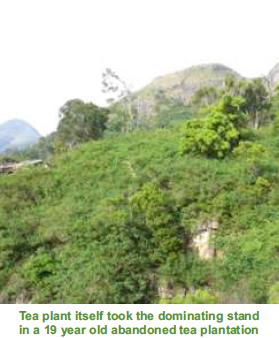
In the mid-1800s, many large plantations were established at the expense of natural forest in many parts of India. The British and the subsequent Indian government leased these plantations out to private developers on a long-term basis, usually for a period of 99 years or less. In recent times, many such plantations surrounded by forests have been notified as Protected Areas (PAs). While most of these plantations have continued to function for decades despite falling within the larger boundaries of PAs, many are now being abandoned either due to expiry of leases that have not been renewed or simply due to the decline in profitability of the plantations. What happens to these plantations after they are abandoned?
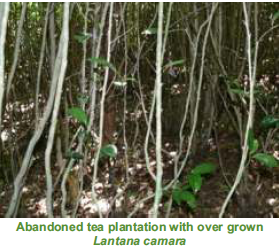
Following abandonment, if a plantation is left unmanaged and undisturbed, it experiences different colonization patterns depending on its location. Many invasive species colonize the plantations at different elevations in the Agasthyamalai hills. At the elevational range of 900-1000 metres above sea level, Lantana camara took over about 60 to 70 % of the area in a 19-year-old abandoned plantation (photo 1). A similar trend has been observed even in recently (7 years old) abandoned plantation in Ponmudi (Kerala) with many invasive species such as Eupatorium sp, Cromolaena odorata and Lantana camara overgrown in the 600 to 1000 meters elevation range. Many studies have highlighted that invasive species lead to changes in community composition and therefore can affect native species recovery in such plantations. At elevations of 1300 msl and above abandoned tea plantations had re-gemerate after the 19th year of abandonment (Photo 2). In such cases tea grows into tall trees completely shading the understory affecting the recruitment of native species.
- Chetana H C
chetana.hc@gmail.com
When people encroach on 'GODS' land
The KMTR eastern boundary is about 75 km long and in most places it abuts agriculture fields and in a few areas, roads and human settlements. It is therefore natural to expect large-bodied wildlife, particularly mammals, coming closer to human habitation thereby creating unpleasant situations for both the animals and the humans. Several species of wildlife such as wild boar, sambar, bear, leopard and elephant have come in conflict with humans along the boundary of the reserve. Though the most common raider is the wild boar, the most feared animal is an avatar of Lord Ganesha - The Elephant. However, elephants are rarely seen in the foothills outside the reserve except during the winter and that also only in a few areas like Pulavan Kudiyirupu, Boothathan Kudiyirupu, Pilavakal Esakkiamman temple, Neduvilai in the Kalakad region and Pottal near Singampatti. The reason is elephants in KMTR move between the dry forests in the lower hills and the wet evergreen forests and grasslands on top of the mountains. When we start seeing Elephants in Kodayar we know that summer is on as these animals move to greener pastures in the hills. Similarly in the winter after the north east monsoons the elephants are mostly in the foothills and forage on the grass and herbs easily available in the dry forest and open areas. The foothills besides being flatter, also support broad rivers, reservoirs, and are covered with scrub which grows abundantly along the forest boundary. Elephants have been coming regularly for centuries to these places and peacefully going back to the hills, so why is this conflict happening now?
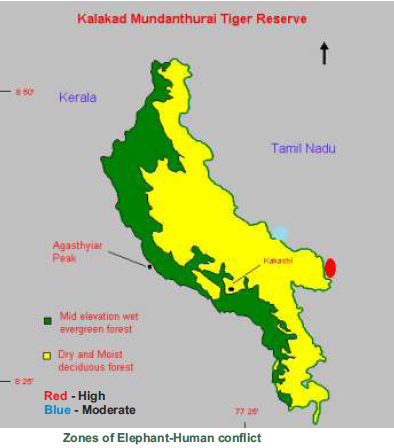
In recent times, scrub jungle in the private properties outside the reserve boundary that elephants have been using has been converted to plantations as in the Padmaneri side near Kalakad leading to habitat loss for them. It also made elephants visible from a distance and therefore creates panic among both animals and humans. With access to groundwater, more areas closer to the forests are cultivated with crops such as banana, coconut, sugarcane, palm, cashew and groundnut which are favoured by the elephants and thus lead to crop raids. Therefore, because of a combination of habitat loss and the availability of attractive crops both in terms of access and nutrition they move into human dominated areas frequently. Moreover, once elephants know that these crops are available on a regular basis they will raid repeatedly every year. On an average, the FD is left with paying over Rs. 3.4 lakhs a yearas compensation.
Though efforts like electric fence and elephant trench are being tried in many places, they offer only temporary relief since elephants quickly learn to adapt and overcome such barricades. It is time the FD and district administration look at this problem from the wild animal and people's point of view. Elephants are not permanent residents in the foothills and they use the conflict area only on passage to move into richer habitat inside the reserve. A habitat buffer around places of conflict needs to be maintained with native tree species. No developmental activities should be allowed in the habitat buffer and such areas should be strictly treated as ecologically sensitive zones. People have to be discouraged from settling in such areas and FD should not pay compensation if this is violated. Until such measures are taken wildlife-human conflict will be a contentious issue in the landscape for years to come and more money and time will be spent on short term mitigating efforts which the elephants and other animals will outsmart sooner or later as in many other places.
- T Ganesh
tganesh@atree.org
An untold fallout of wildlife conservation
One night while sampling for frogs in the paddy fields of Singampatti village, we saw a grim shine on a pair of eyes at about 30 m away. Seshadri took out his powerful torch just in time to throw some light on a jackal running into the nearby banana plantation. Apart from the amphibians we were sampling in our night surveys, we saw surprisingly little animal life - about eight crabs, two snakes, two tortoises, one scorpion and one Jackal. How was the scenario a few years earlier? Although not my primary research interest, I nevertheless tried to find this out during my interviews with the farmers whose fields we were sampling. All the farmers who I spoke to about the past biodiversity told how they used to find many species of frogs in the fields and the collective croaks was so much that one could not hear a man three feet away. They also spoke of a time when people of a certain caste used to come just to catch fish from the paddy fields. Now, one can hardly find any fishes. Crabs were plenty and so were the sightings of foxes around the paddy fields. All farmers had only one reason for the reduction in animal life around the villages - increase in the use of chemicals in agriculture. From my data sheets, I noticed that some farmers were paying about Rs. 600 per cart load of cow dung for fertilizing their fields. Although this form of fertilizer is still popular, it is too expensive and it is being substituted with chemical fertilizer. When I asked farmers why dung had become expensive, they said that before the implementation of conservation laws, each house used to have about 50 cows in contrast to the barely one or two cows that they have now. Since they had no other land to graze their cattle, they had to sell their cows. There is no doubt that many other economic factors had also contributed to the decrease in cattle population. Given these factors, I am not sure how much difference it might have made to biodiversity outside the forest if alternate grazing land was provided but it appears that it would have been better than what it is now. Conservationists are known to ignore fallouts of conservation actions on human well-being but when the fallout starts adversely impacting conservation of biodiversity itself (only elsewhere), it is time to question their wisdom.
- Allwin Jesudasan
allwin.jesudasan@atree.org
Harnessing weeds for alternate use
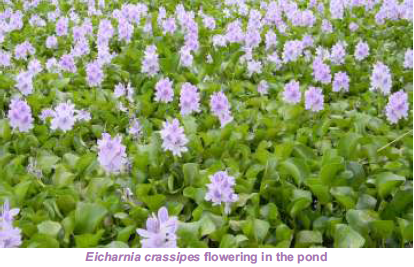
In Tirunelveli and Thoothukudi region, more than 3000 tanks receive water from the perennial Thamirabarani river and its tributaries through an intricate network of canals. These tanks and canals not only support agriculture but also a diverse assemblage of wetland plants, birds and other animal communities. I recorded 198 plant species including 5 major invasive species from about 200 tanks. Some of the invasive wetland plants are Eichhornia crassipes (Aagayathamarai, Water hyacinth), Alternanthera philoxeroides (nai ponnanganni) , Ipomea fistulosa (velikkathan), Hydrilla verticillata and Salvinia molesta.
Invasive plants are typically introduced from elsewhere and adapt well to most adverse conditions and aggressively displace the native plants in the wetlands. Though known for their reproductive ability to spread in a short span of time the main catalysts for them to proliferate are the flow of sewage and farmland runoff into the wetlands.
As invasive plants are perceived as weeds we do not consider them useful. However, of late it has been realized that eradicating or controlling the weedy plants is not possible; rather they have to be put to some use to manage their spread. It looks like the animals which are associated with the wetlands infested by weeds are ahead of humans in practicing 'weed management' by nesting or roosting on them as well as using them as foraging grounds since the weed beds abound with food materials. Humans are not far away either. As these plants store mineral traces from the polluted water in addition to carbon and nitrogen, they are being used as green manure. Further, since they bind well with clay in the form of silt they can be useful for farming. Nowadays water hyacinth is also used as raw material in paper industry and for making furniture by local communities. Several possibilities have been explored in using Aagayathamarai as a source for biomass-based energy generation by researchers, though it has not been commercialized. On the other hand, Alternanthera philoxeroides is used as fodder especially by buffalo which feed voraciously while they wallow in the wetlands.
The invasive plants are quickly replacing our essential native plants. Although there are no means of completely eradicating them, they can be managed by putting them to alternate use. The current practice in the villages of Tirunelveli district to completely remove through manual or mechanical means are only short term expensive measures. I feel that sustained use of weeds for economic/livelihood/cash-income purposes could be a better option.
- Saravanan A
saravanan.amavaasai@atree.org
Nature Tourism at crossroads
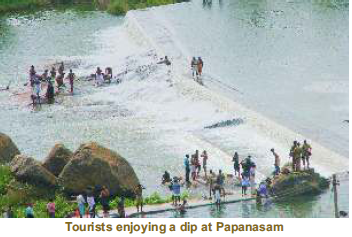
Tinnevelly may be considered as an epitome of the whole Madras Presidency ,almost every feature of which is repeated on a smaller scale within this little area - A.J.Stuart, 1879.
The above quote holds true even for nature tourism within Tirunelveli district as it is bordered by sultry beaches, desert like 'theri' landscape with shifting sand dunes, arid grasslands with sparse tree cover, wetlands and rivers with reed cover, and cooler mountain tops with cascading falls on par with Ooty / Kodaikanal. Generally people from other districts shun going to the southern districts of Tamil Nadu during summer due to scorching temperature but the 'localites' daringly go out in summer starting from Nambikovil in the south to Courtallum in the north, all along the forested eastern slopes of Agasthyamalai. Most of the sites they visit are associated with waterfalls along rivers that descend from forests with a temple on its banks or tea plantations and dams in the higher hills. KMTR is famed for its water sources and is popularly known the River Sanctuary'.
Recently however, a ruling by the Supreme Court of India has threatened to take away the joy of people visiting Protected Areas, which would no less affect the Tinnevelians too. The order's main objective was to ensure biodiversity conservation through regulation of an overtly tiger centric tourism. Following NTCA's guidelines and with guidance from the stakeholders forming the Local Advisory Committee, KMTR Tiger Foundation carved out certain areas for regulated tourism following non-intrusive tourism practices. The idea behind this was to garner support from the forest dependents and visitors for biodiversity conservation because it could a) improve the livelihoods of the forest dependents and b) visitors could become ambassadors for the biodiversity. Ultimately biodiversity conservation could lead to a secured flow of services to communities which are even farther away from forests. However after 2 meetings a status quo was maintained.
People with more disposable income in hand as well the one who want to elevate themselves from 'mass' to 'class' social status add more pressure on forests in addition to people who come to KMTR traditionally for performing religious and cultural practices. Incessant traffic flow that bring loads of non-biodegradable polythene products, liquor bottles (left as splinters), food refuse, soaps, shampoos and detergents are left as trash and pollutants in the forest and rivers. Not to blame the visitors, who do not have time to think about the value of natural heritage they have been endowed with and to be inherited safely by the future citizens by following the ethics of nature tourism. Literally they rush to yet another waterfall before their wet clothes dry. How the foundation copes with all of these issues when conflicting pressures come from the center, state, NGOs and local stakeholders is something worth watching.
- R Ganesan
rganesan@atree.org
Do we need a buffer around KMTR?
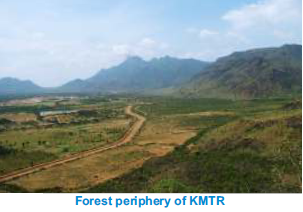
Most protected areas in India have a 'buffer' around them where ecologically harmful developmental activities are curtailed. There are enough laws and rules that attempt to make sure that this buffer exists. However developmental, political and economic pressures are violating and amending these rules on a regular basis and KMTR is no exception. We explore how important is the buffer or Ecologically Sensitive Zones (ESZ) as it is now called, for KMTR. Within 5 Kms from the forest boundary of KMTR there are many granite quarries, spinning mills and chemical industries while newer unregulated developments like real estates, private farms and monoculture tree plantations are escalating. So what do these mean to KMTR and biodiversity in general? The areas where granite quarries are located provided important habitats for several species of animals that are useful for agriculture, such as owls and other birds which feed on rodents and harmful insects. Many herbs were collected from these areas that were used in medicines. These places were also used by people to graze livestock and collect fuelwood. These areas also allowed for water conservation and recharge since they were usually on a slope with lots of dense scrub growing around boulders. Quarrying also leads to extensive dust and noise pollution, water bodies gets affected and weak buildings in the neighbourhood crack because of the explosions. Polluting industries not only pollute the air and water but extensively draw water meant for irrigation and also affect the health of the rural poor. All such activities next to KMTR affect movement of wildlife. Elephants have lost their habitat, others such as wildboar, sambar and leopards are coming into increasing contact with humans because we are encroaching too close to their homes, thus creating conflict situations. The State Government and Forest Department should rethink about these issues and should insist on having a buffer around KMTR as designated ESZ. The extent of the buffer should be decided upon in consultation with people, environmentalists, local NGOS and other stakeholders that are affected. This is an urgent conservation issue for KMTR.
- M. Mathivanan and T Ganesh
mathi@atree.org
Wetlands and Society
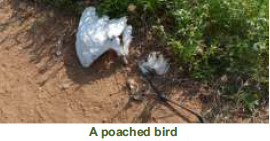
The wetlands in the Thamirabarani basin have now been surveyed during the last three years during the peak of winter. Over 120 volunteers from the districts of Tirunelveli and Thoothukudi have been involved in these surveys that last for two days during the third and fourth weeks of January and people from all walks of life get to witness the diversity and congregation of large groups of water birds in the river basin. These activities have led to the generation of information on the status of wintering and resident water birds in the region and more importantly bring out the issues that affect their sustenance in these areas.
First and foremost, as with the case of the loss of habitat due to reclamation, that is so often quoted as the biggest threat to wetland birds globally; issues in this area come in the form of chopping of nesting and roosting trees and the transformation of smaller wetlands to cropland. Threat also comes in the form of poaching that goes unnoticed. During the last few surveys, volunteers have often come across many sites where traps and skinned birds have been encountered. Fireplaces on tank bunds scattered with the remnants of hunting instances have been noticed. This is also true for other life forms like turtles and lizards particularly towards the lower end of the Thamiraparani basin where flatshell turtles have been extensively collected from few tanks.
The social forestry program had planted Acacia nilotica in the tanks to meet the fuelwood and timber requirements of villages. The spinoff of this has provided suitable habitats for many waterbirds to roost and nest. However, this scheme is no longer actively pursued and most trees have been chopped by forest contractors depriving birds of their habitat and also the local people of the timber and fuel wood.
The planting of trees in the foreshore as part of a community activity that meets the demands of fuelwood and also serve as site for roosting and nesting birds could be an approach that would lead to the involvement of various stakeholders.
- Prashanth M B
prashanth.mb@atree.org
Disappearing 'Wastelands'
Appleton's 'prospect-refuge theory' states that people prefer locations similar to the savanna grasslands in Africa as these settings afford both prospects and provide refuge; they offer the opportunity to “see without being seen” which helps them stalk prey and also hide from enemies. This is so imbibed in our psyche that even today we prefer parks in cities that mimic savannas and are averse to wooded parks as they are associated with crimes. At the other extreme we are so tree centric in all our conservation efforts that a great proportion of our PAs have woody landscapes. Grasslands, or 'wastelands' as they are called, fall prey either to infrastructural development or to high input tree centric farming such as coconuts which are alien to the agro-climate of the region.
The plains abutting the mountains of Agasthyamalai region on the eastern side had a large expanse of these habitats which is fast disappearing. On a train ride from Madurai to Thoothukudi, one cannot miss the grasslands punctuated with towns or invasions of Prosopis. The expanse gets larger as we move closer to Kovilpatti. Overall there is shrinkage of these habitats in recent times.
These grasslands have unique fauna even today although the mammals such as black bucks, Indian foxes , wolves might just occur in some pockets. In fact, the now extinct Cheetah, a grassland specialist was also recorded in the Tirunelveli grasslands. However, a day out in these landscape even today can never be disappointing with the grey partridge calling ' Kapil dev , Kapil Dev…,' and the fan-throated lizard displaying their beautiful blue gular pouch trying to woo its partner. You cannot miss the monitor lizard run clumsily, a black naped hare scurry away or a quiet harrier take off. We once bumped into a pair of Savanna nightjars in a patch of these grasslands in Kadana area. Unfortunately even that patch has fallen prey to coconuts and Emu farms!
Grasslands are important grazing areas for sheep farmers of the region who travel to various parts of the districts in search of fodder taking advantage of rainfall patterns which vary within the region offering resources at various times. Western countries now have labels such as 'Happy Chicken' which pick up higher prices compared to pen fed ones. They have now started establishing ranches for them where they can freely feed. We in India have to conserve free ranging goats and sheep which are already a part of our system. There is still ample scope to establish a network of grasslands reserves in the regions through community reserves, buffers zones and eco sensitive zones.
- M SoubadraDevy
soubadra@atree.org
Tales from wilderness
A Kani perspective on naming the frogs
While screening pictures of frogs on my computer screen, I could sense Arumugam, an assistant from the Kani community of Karayar forest, looking over my shoulders curiously at the pictures. I soon engaged him in a conversation on frogs. He knew the names of about 10 most common frogs. He also described how certain frogs lay their eggs in froth made on the leaves hanging over forest streams.
Interestingly, he narrated the entire life history of a beautiful frog which he called 'Kooran thavalai'. The name 'Kooran' means Mouse deer/Chevertan. He said that it eats droppings of mouse deer in addition to 'Pulicha' ('Oxalis' sp.) leaves and worms.
Frogs eating leaves came as a surprise to me for the second time. Fifteen years ago, Kannan, another assistant working in a Cardamom estate told me that frogs are pests as they chew on young fruits of cardamom and I did not take it very seriously that time.
Arumugam called the Wrinkled frog (Nyctibatrachus) 'Pillaithavalai' as its characteristic wrinkled skin resembles a newly-born baby's skin. Similarly, as most of the bushfrogs and the Kalakad tree frog resemble dried leaves, the name for them was 'unakkan' meaning dried.
Arumugam's knowledge of frogs came mainly from the interaction with elders in the forest when they ventured out for collection of forest produce ,besides his own observations. This discussion with Arumugam further strengthened my belief that interaction with nature can teach a lot and make one wiser too. The earlier occasion with similar experience which I had was with 'Kuravapathu Murugesan thatha' (refer Agasthya http://agasthya-kmtr.blogspot.in/2009/04/leaf-out-of thathas-diary.html). Arumugam's could be the last generation with an opportunity to learn from nature under the supervision of elders as most from the current generation have distanced themselves from nature in the name developments.
- R Ganesan
rganesan@atree.org
Research Highlights
PILGRIMS ALONG ANIMAL TRAILS
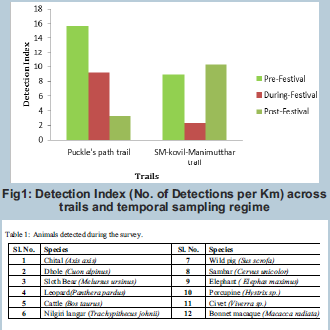
Sorimuthu Iyyanar kovil (SM Kovil) temple premise is an ancient religious enclave within the Mundanthurai plateau region of Kalakad Mundanthurai Tiger Reserve (KMTR). During the 'adi-amavasai' festival, people come in huge numbers to pay obeisance to the deity/god Sorimuthu Iyyanar and the customary Zamindar of Singampatti palayam, who also presides over the temple trust.
To study the impact on animal movements during the festival, we designed a survey in 2008 by selecting 5 widely used animal trails. They were Karayar-Servalar (KS), Puckle's Path (PP), Karayar-SM Kovil (KSM), Servalar Lower Camp (SLC) and SM Kovil-Mannimutthar (SMM). The 26 day survey was divided into three temporal sampling regimes: Pre-festival, During Festival and Post festival. Sampling effort corresponded to the number of KM walked and detections included animal droppings, tracks and direct sightings.
Totally 53 kms were covered out of which 19 kms were walked during-festival, 13 kms post festival & 21kms during the pre-festival period. The sampling effort in the pre-festival period was low due to heavy rains. The detection index (No. of Detections per Km) across trails and temporal sampling regime is also shown in fig 1.
The animals detected during the survey are enumerated in Table 1. The detection index followed the order of: Pre-festival>During festival>or < Post festival. The detection index was high during the pre-festival period in Puckle's path and Karayar-SM kovil trail whereas it was low in the post festival period in both these trails. In the SM-kovil- Manimutthar trail detections were high in the post festival and pre-festival periods while they were lower in during the festivals. One possible reason for the low detection index in the SM-kovil-Manimutthar trail during the festival is that the trail experienced high human activity once the festival started as camps were concentrated in high densities in and around the trail.
The detection index in the SM-kovil- Manimutthar trail was higher in the post festival period as compared to the detection index recorded during the pre- festival period (fig 1). A probable reason might have been the presence of food refuses / left-over food which may have attracted lot of wildboars as the detections in this segment during the post-festival period revealed. Other high detections were of animals such as sambar, dhole and chital which might also have been attracted by the wastes left-behind by the retreating pilgrims, tourists and other visitors.
This particular study showed that the festival has a more direct impact on the animal movements. This, in the long run, can have wider implications on animal abundances, their behaviour and on the overall ecological health of the area.
- Rajkamal Goswami
rajkamal@atree.org
Snippets:
- Two white-necked storks were seen in a harvested paddy field near Kallidaikurichi on 17th March 2013 and again on 24th March. M. Mathivanan.
- One white-necked stork was sighted and photographed at the ACC on 5th April. S. Tamizhazhagan.
- Nesting of pelicans and storks was not recorded in Koonthankulam and Tirupadaimarathur bird reserves probably due to scanty rainfall. T. Ganesh.
- Tamil Nadu Forest Department, Thoothukudi division and Pearl City Nature Society jointly conducted Black buck census in Vallanadu Black buck sanctuary on 27 March 2013. 75 Black buck, two Spotted deer and one Sambar deer were recorded in the census. -Source K. Vijayavel.
- Caspian plover was sighted in Vijayanarayanan. Seshadri and Prashanth M B
- A possible harrier roost was recorded in Vijaynarayanan. T Ganesh.
- Flocks of over 130 flamingoes were sighted in Perungulam, Kadambakulam, Karunkulam, Rajavellipuram and Kuppa Kurichi. One solitary bird was sighted in Kabali Paarai. Prashanth M B
News:
- R. Ganesan represented ATREE for Local Advisory Committee (LAC) meeting organised by Tamil Nadu Forest Department, Kalakad Mundanthurai Tiger Reserve (KMTR) at Mundanthurai
- T.Ganesh, Prashanth M.B, Seshadri K.S. and M. Mathivanan carried out a biodiversity survey in Kattabomman Indian Navy Service (INS) campus at Vijaynarayanan on 31 Jan 2013.
- Construction of a guest house at the ACCC has begun. M. Mathivanan.
Talks, Presentations and Publications:
- Jesudasan, A. 2013. Reconciling 'us' and 'them' - The Sori Muthu Iyyanar temple-KMTR experience. Protected Area Update. XIX,1(24).
- H.C. Chetana was awarded Doctor of Philosophy by Manipal University for this thesis titled, "Assessing the ecological processes in abandoned tea plantations and its implication for Ecological Restoration in the Western Ghats, India".

